

(1 of 9) Growing Tomatoes & Peppers: When to Seed Start, Starting Mix, Light, Watering & Feeding. When to Plant Vegetables in Winston Salem, North Carolina. Planting Calendar: When to Plant Vegetables. Vegetable Gardening Calendar Enter your location in the field above to get customized planting dates.
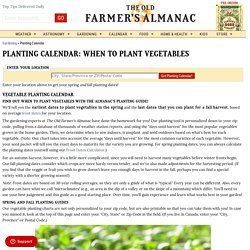
How to Prepare Garden Soil for Planting. Healthy soil is the basis of healthy plants and a healthy environment. When garden soil is in good shape there is less need for fertilizers or pesticides. As author and respected gardener Frank Tozer writes, “When building soil you not only improve your plants health, but you can also improve your own.” Organic soil is rich in humus, the end result of decaying materials such as leaves, grass clippings and compost. It holds moisture, but drains well. Kitchen Garden Plants: Vegetables for Containers and Small Spaces. Kitchen gardens—grown for eating and cooking—are often grown in smaller spaces and containers.
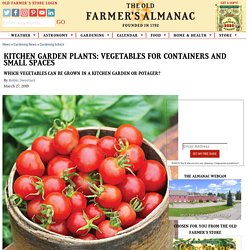
So, keep an eye out for plants bred for small spaces! Here is a short list, including cherry tomatoes, Little Gem lettuce, peppers, eggplant, and more. Many dwarf-sized plants bear diminutive fruit as well but will make up for the smaller size in the great quantity they produce, while others manage to bear full-sized fruits on a much smaller scale than normal plants. North Carolina Extension Gardener Handbook. Vegetable Gardening: A Beginner's Guide. Vegetable gardening is becoming more popular—both as a pastime and a food source.
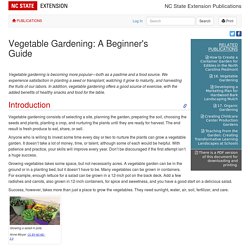
We experience satisfaction in planting a seed or transplant, watching it grow to maturity, and harvesting the fruits of our labors. In addition, vegetable gardening offers a good source of exercise, with the added benefits of healthy snacks and food for the table. Vegetable gardening consists of selecting a site, planning the garden, preparing the soil, choosing the seeds and plants, planting a crop, and nurturing the plants until they are ready for harvest. The end result is fresh produce to eat, share, or sell. NC State Extension Publications. Harvesting Vegetables - Taste of Gardening - University of Illinois Extension. Biggest Is Not Always the Best Most crops can be harvested several times if only the part that is ready is harvested.
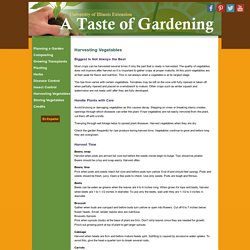
The quality of vegetables does not improve after harvest so it is important to gather crops at proper maturity. At this point vegetables are at their peak for flavor and nutrition. This is not always when a vegetable is at its largest stage. The ripe time varies with certain vegetables. Handle Plants with Care Avoid bruising or damaging vegetables as this causes decay. Tramping through wet foliage helps to spread plant diseases. Check the garden frequently for ripe produce during harvest time. Choosing the Right Mulch for Vegetable Gardens. Shopping for Healthy Plants - Growing A Greener World® Roots are a good indication of the health of a plant Spring fever will strike at any moment.

How to Plant A Tree the Right Way - 7 Steps for Getting it Right Every Time - Growing A Greener World® With a little luck and good timing, sometimes simply sticking a tree in the ground and walking away can be enough for it to survive.

But knowing how to plant a tree the right way, will ensure success every time. In my book, there are 7 steps for planting success which I share below. How to Plant Containerized Trees. How Much Water do Annual Flowers Need? All plants need water, but since annual flowers tend to have shallow root systems and we expect them to spend almost their entire life blooming repeatedly, they need extra care.
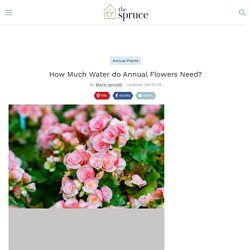
If they get stressed, they will either rush to set seed and not bloom again or slowly die. You can't really set a schedule for watering plants. Even if you have a drip irrigation system, you'd be wise to have a timer that can detect if it is raining. There are several caveats to factor in, but you should find a good balance if you follow a few simple guidelines to finding the right amount to water.
The Weather If it rains, you might not need to water. Other weather factors to consider are sunshine, heat, and wind. Wind is an often overlooked element, but it can desiccate leaves and even dry the soil. Soil Quality. When Is the Best Time to Water Plants? Perennial Flowers That Bloom All Summer. Directory of Annuals - Gardening with Annuals - University of Illinois Extension. Composting Tips & Tricks. A Best Seller!

(Free Shipping) 1. Grass clippings add necessary nitrogen to a compost pile, but be sure to mix with the “brown” materials that add carbon. Both are necessary for quick decomposition and rich compost. Piles made up of just grass will compact, slow down and start to stink. 2. 3. 4. 5. 6. 7. How to Mulch Your Garden - 6 Kinds of Mulch and When to Use Them. How to Mulch Your Garden - 6 Kinds of Mulch and When to Use Them. How to Create and Maintain an Indoor Worm Composting Bin. Reduce, Reuse, Recycle. Compost is organic material that can be added to soil to help plants grow.
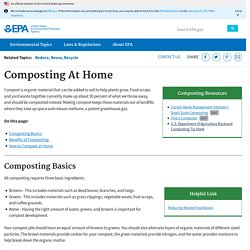
Food scraps and yard waste together currently make up about 30 percent of what we throw away, and should be composted instead. Making compost keeps these materials out of landfills where they take up space and release methane, a potent greenhouse gas. On this page: Composting Basics All composting requires three basic ingredients: Browns - This includes materials such as dead leaves, branches, and twigs. Your compost pile should have an equal amount of browns to greens. Benefits of Composting Enriches soil, helping retain moisture and suppress plant diseases and pests. How to Build a Raised Garden Bed: Planning, Building, and Planting. Stitcher. NPR Choice page. MARGARET ROACH A WAY TO GARDEN on Apple Podcasts.
Melissa Roach has a gardening podcast that is available free on apple podcast. – mclinste
Creative Vegetable Gardener:The Best Vegetables to Grow in a Community Garden Plot - Creative Vegetable Gardener. Growing food in a community garden plot is a very unique style of gardening with great benefits and some tough challenges that home gardeners don’t experience.
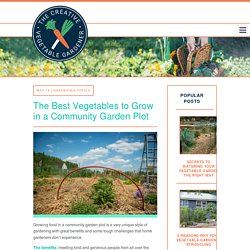
The benefits: meeting kind and generous people from all over the world who share a love of gardening and learning from each of them by watching what they grow and how they set up their gardens. The challenges: the far distance from your house which often limits how frequently you can visit your garden, and the difficulty of managing your garden from afar. If you’re not careful, these challenges can make community garden plots feel more like a burden than a joy.
But, don’t worry! Best Plants for a Community Garden in Moderate Climates. 16 plants that repel unwanted insects. Are you an insect magnet?
This article lists plants and flowers that can be planted in garden to repel insects that may harm the vegetables growing in your garden. – mclinste
If you aren't, you probably know one. Insect magnets attract annoying insects the second they walk outdoors — or so it seems. If this describes you, take comfort in knowing that one of the ways you can fight back against mosquitoes, gnats, flies, no-see-ums and other pesky bugs doesn't have to involve covering yourself with a sticky spray or engaging in chemical warfare. To help you enjoy going outdoors, try strategically placing insect-repelling plants in your garden or on your patio.
Essential oils in these plants act as nature's bug repellent. Top 10 vegetables to grow in your garden. A perfectly ripe, juicy tomato, still warm from the sun. Sweet carrots, pulled from the garden minutes (or even seconds!) Before they're eaten. Growing your own vegetables is one of those activities that balances practicality and indulgence. In addition to the convenience of having the fixings for a salad or light supper right outside your door (or on your windowsill), when you grow your own vegetables, you're getting the most nutritional bang for your buck as well.
Vegetables start losing nutrients as soon as they're harvested, and quality diminishes as sugars are turned into starches. 1. Watch out for cabbage worms when you grow broccoli (Photo: alexpro9500/Shutterstock) Tips on starting a community garden.